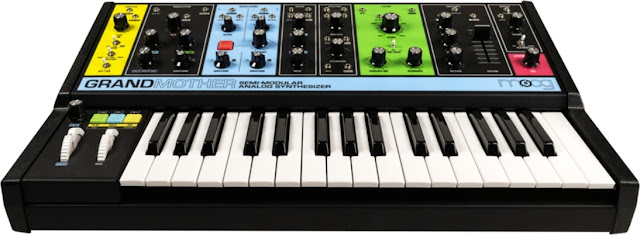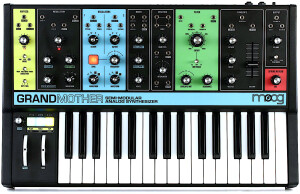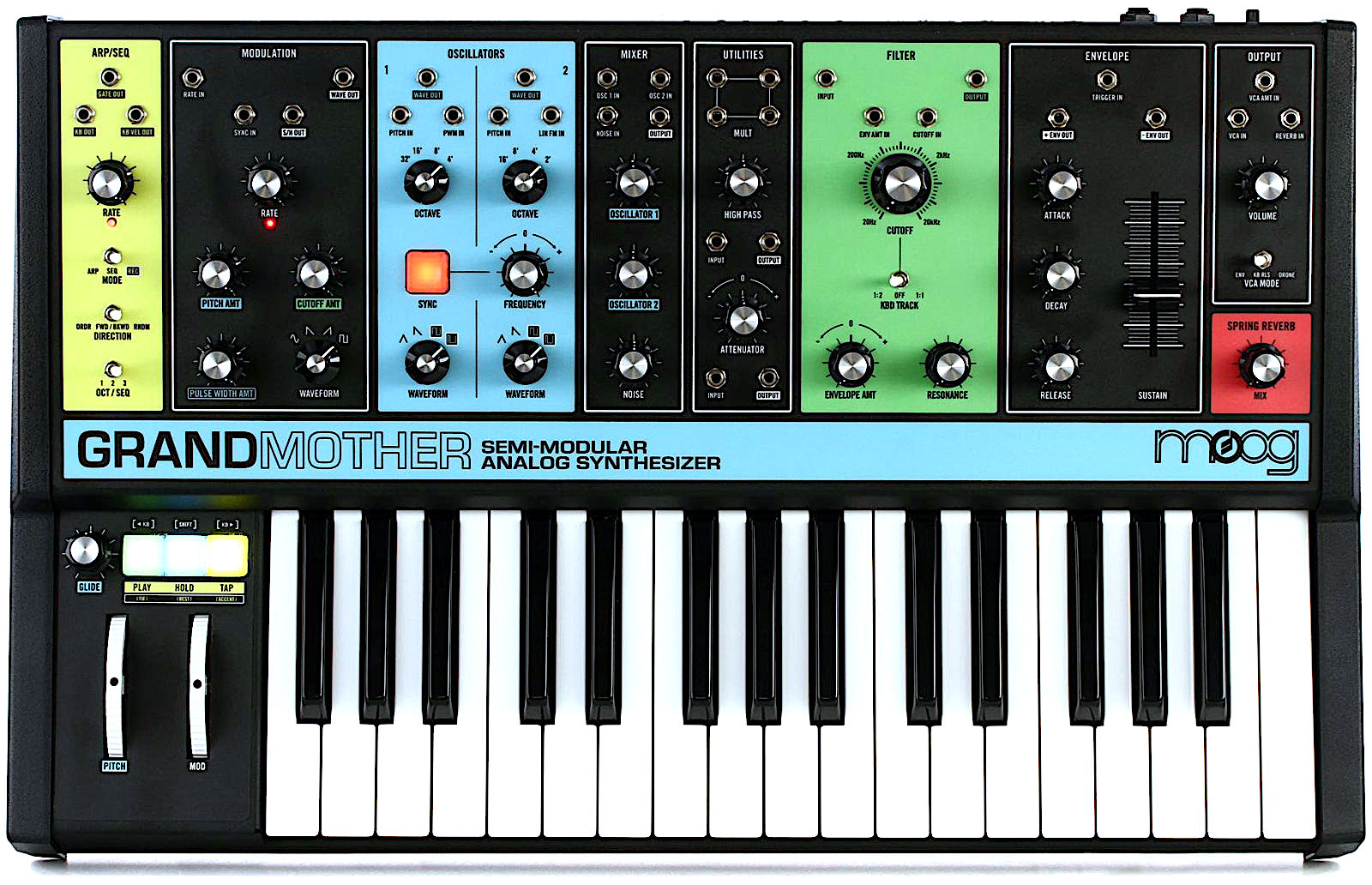Moog Grandmother
- 48 réponses
- 21 participants
- 8 608 vues
- 23 followers
dédé la joncaille
1518
AFicionado·a
Membre depuis 11 ans
Sujet de la discussion Posté le 11/05/2018 à 21:41:46Moog Grandmother




"Limited-edition design created exclusively for Moogfest 2018.
To celebrate Grandmother’s debut at Moogfest 2018, the first 500 units have been marked with a limited-edition Moogfest 2018 badge and include a custom denim jacket from Moog. Get your Grandmother Moogfest 2018 Edition before they're gone!
Retro looks, cool vibe and a sound that's all Moog. Grandmother is a direct reflection of Moog's modular heritage, where the journey to creating sound is as much fun as the end result. There are no presets, so you'll have to rely on creative exploration and a basic understanding of synthesis to achieve any desired results, but nothing can compare to the joy and satisfaction of creating your own custom sounds. Just like its vintage predecessors, Grandmother's sound engine, modulation engine and onboard spring reverb tank are 100% analog. Want proof? Just give the desk a bump and listen to its springs rattle inside. With Grandmother, what you see is what you get. No menu diving, no recall, nothing to get in the way of you and your sound.
The Grandmother is a semi-modular synth, which means you can start playing it right out of the box without any patching. But if you want to experience the full creative potential of Grandmother, just use any of its 41 patch points to override its internal circuitry and create your own complex signal routing. Choose from 21 inputs, 16 outputs and a parallel-wired 4-jack mult. The options are only limited by your imagination, and with the ability to integrate Grandmother into other modular synths like the Mother-32 or DFAM, or even into larger Eurorack systems, the possibilities are infinite.
Analog Architecture
All the basic building blocks of a modular synth are included in the Grandmother's design, and even some welcomed extras. There are two analog oscillators each with their own selectable waveforms including triangle, sawtooth, square and pulse, with a hard sync button to align them appropriately. The analog LFO is perfect for adding some movement to your sound and with its audio-rate capability, it can act as a third oscillator for bigger, more aggressive sounds. There's also a classic Moog 4-pole 10Hz-20kHz Ladder filter, patchable 1-pole high-pass filter, and an analog ADSR envelope generator ready to sculpt your sound.
Beyond The Basics
The Grandmother would be an excellent machine with only the essentials, but Moog innovates further by adding in an analog hardware spring reverb tank that can add a subtle shine, while taming any harsh frequencies. The reverb tank can also be used to process external sources as a standalone effect. Grandmother also has a built-in arpeggiator that's easy to use and an onboard sequencer that can store up to 3 sequences with up to 256 notes each.
Vintage Vibe, Modern Connectivity
Despite its vintage-inspired design, Grandmother has all of the connectivity needed for a modern production environment. There's a 5-pin MIDI In/Out/Thru as well as MIDI over USB for instant integration with your host computer. Grandmother also features 1/4" main output and a 1/4” external audio input for guitars, drum machines, and more. Grandmother's 32-note premium Fatar keybed makes this a premium standalone synth but will also work perfectly as the front end to an existing modular system. No matter how you decide to use it, Grandmother will give you a lifetime of sound exploration.
Features
100% analog synthesizer with 32-note Fatar keybed
Semi-modular design, requires no patching to play
All normalized connections can be interrupted for full modularity
Hardware Spring Reverb can be used to process external sounds
1/4” External audio input for guitars, drum machines, and more
Easy to use Arpeggiator and Sequencer
Store up to 3 sequences with up to 256 notes each
2 Analog Oscillators with selectable waveshape and hard sync
Classic 4-Pole 10Hz-20kHz Ladder filter
Patchable 1-Pole High Pass filter
Analog ADSR Envelope Generator
Analog LFO with audio-rate capabilities
DIN MIDI In/Out/Thru and USB MIDI
Patchable bipolar attenuator
Works with Mother-32, DFAM, Eurorack modular systems and more
41 patch points with 21 inputs, 16 outputs and a Parallel-Wired 4-jack Mult"
$899.00 List $999.00
source : https://www.matrixsynth.com/2018/05/meet-new-moog-grandmother.html?m=1
[ Dernière édition du message le 12/05/2018 à 05:51:19 ]
bbbici
6
Nouvel·le AFfilié·e
Membre depuis 13 ans
41 Posté le 29/10/2023 à 17:41:30
Merci à vous 2 pour votre temps. J’y vois beaucoup plus clair grâce à vous.
Ça étend quand même pas mal les possibilités du GM. C’est le seul synthé que j’ai et j’aime l’idée de pouvoir faire des petites nappes avec.
Merci encore.
Ça étend quand même pas mal les possibilités du GM. C’est le seul synthé que j’ai et j’aime l’idée de pouvoir faire des petites nappes avec.
Merci encore.
0
petit professeur
4152
Squatteur·euse d’AF
Membre depuis 16 ans
42 Posté le 29/10/2023 à 21:27:02
x
Hors sujet :J’ai pas de GM mais de mémoire tu peux utiliser le LFO comme un 3eme oscillo donc faire des nappes à 3 notes
0
Le plus gauche des guitaristes gaucher....
stiiiiiiive
3650
Squatteur·euse d’AF
Membre depuis 22 ans
43 Posté le 29/10/2023 à 21:47:20
Avec plaisir bbbici 
@petit professeur, oui, avec n'importe quel synthé à plusieurs oscillos, on peut commencer à tâter l'harmonie. Mais jouer des intervalles différents reste une aventure :D
@petit professeur, oui, avec n'importe quel synthé à plusieurs oscillos, on peut commencer à tâter l'harmonie. Mais jouer des intervalles différents reste une aventure :D
0
*Seed*
11607
Drogué·e à l’AFéine
Membre depuis 18 ans
44 Posté le 30/10/2023 à 00:00:53
x
Hors sujet :Ce qui est intéressant avec ce module c'est la capacité de rendre le polychain possible sur des machines pour lesquelles c'est pas implémenté, ou mal comme le little phatty à ce qu'il semble. Bon après faut un sacré bufget pour un little phatty à 4 voies mais avec des modules de chez behringer ç'est plus abordable
0
Sysex and sun
petit professeur
4152
Squatteur·euse d’AF
Membre depuis 16 ans
45 Posté le 30/10/2023 à 06:28:00
Citation de stiiiiiiive :
Avec plaisir bbbici
@petit professeur, oui, avec n'importe quel synthé à plusieurs oscillos, on peut commencer à tâter l'harmonie. Mais jouer des intervalles différents reste une aventure :D
Je voulais dire, on peut utiliser le GM en paraphonie à 3 notes avec le module sus nommé, en utilisant le LFO comme 3eme oscillateur.
0
Le plus gauche des guitaristes gaucher....
stiiiiiiive
3650
Squatteur·euse d’AF
Membre depuis 22 ans
46 Posté le 30/10/2023 à 13:33:06
@petit professeur, au temps pour moi, j’avais mal compris 
Justement, j’ai eu la chance de jouer d’un Voyager Old School et j’ai enregistré deux ou trois petits morceaux faisant entendre des accords : un oscillateur sur la fondamentale, un autre sur la tierce… modulée entre majeure et mineure grâce à la molette de modulation ; avoir les trois oscillateurs rendait le truc un peu trop rigide à mon goût. Les accords sont des empilements de tierces, si on va un peu plus loin que de plaquer des accords, on peut obtenir des résutats qui donnent l'illusion d'accords à trois sons et sont un peu plus dynamiques au besoin. Pis y a souvent d'autres instruments autour pour préciser l'harmonie.
Dispo ici, c’est une vieillerie simpliste qui m'avait amusé.
@*Seed*, oui c’est clairement un bon plan pour ça. Avec le Little/Slim Phatty, j’avais fait des tests avec trois unités et clairement, ça allait beaucoup mieux si le contrôleur n’envoyait pas de MIDI clock. Si le LP était le contrôleur… oué, un coup oui un coup non
Justement, j’ai eu la chance de jouer d’un Voyager Old School et j’ai enregistré deux ou trois petits morceaux faisant entendre des accords : un oscillateur sur la fondamentale, un autre sur la tierce… modulée entre majeure et mineure grâce à la molette de modulation ; avoir les trois oscillateurs rendait le truc un peu trop rigide à mon goût. Les accords sont des empilements de tierces, si on va un peu plus loin que de plaquer des accords, on peut obtenir des résutats qui donnent l'illusion d'accords à trois sons et sont un peu plus dynamiques au besoin. Pis y a souvent d'autres instruments autour pour préciser l'harmonie.
Dispo ici, c’est une vieillerie simpliste qui m'avait amusé.
@*Seed*, oui c’est clairement un bon plan pour ça. Avec le Little/Slim Phatty, j’avais fait des tests avec trois unités et clairement, ça allait beaucoup mieux si le contrôleur n’envoyait pas de MIDI clock. Si le LP était le contrôleur… oué, un coup oui un coup non
0
[ Dernière édition du message le 30/10/2023 à 13:36:44 ]
*Seed*
11607
Drogué·e à l’AFéine
Membre depuis 18 ans
47 Posté le 30/10/2023 à 13:59:05
C'est probablement la lecture de ton avis que j'avais en mémoire quand je disais que ça fonctionnait pas top ... 
0
Sysex and sun
petit professeur
4152
Squatteur·euse d’AF
Membre depuis 16 ans
48 Posté le 30/10/2023 à 18:29:21
Citation de stiiiiiiive :
@petit professeur, au temps pour moi, j’avais mal compris
Justement, j’ai eu la chance de jouer d’un Voyager Old School et j’ai enregistré deux ou trois petits morceaux faisant entendre des accords : un oscillateur sur la fondamentale, un autre sur la tierce… modulée entre majeure et mineure grâce à la molette de modulation ; avoir les trois oscillateurs rendait le truc un peu trop rigide à mon goût. Les accords sont des empilements de tierces, si on va un peu plus loin que de plaquer des accords, on peut obtenir des résutats qui donnent l'illusion d'accords à trois sons et sont un peu plus dynamiques au besoin. Pis y a souvent d'autres instruments autour pour préciser l'harmonie.
Dispo ici, c’est une vieillerie simpliste qui m'avait amusé.
@*Seed*, oui c’est clairement un bon plan pour ça. Avec le Little/Slim Phatty, j’avais fait des tests avec trois unités et clairement, ça allait beaucoup mieux si le contrôleur n’envoyait pas de MIDI clock. Si le LP était le contrôleur… oué, un coup oui un coup non
En plus un défaut du Old School c’est qu’il n’y a pas d’entrée CV par oscillateur, ni de sortie MIDI d’ailleurs alors que la partie clavier est numérique…
Sinon ça fait belle lurette que je ferai de la paraphonie avec le mien 🥰
0
Le plus gauche des guitaristes gaucher....
stiiiiiiive
3650
Squatteur·euse d’AF
Membre depuis 22 ans
49 Posté le 30/10/2023 à 22:43:27
Vrai ! C'est aussi ce qui m'avait motivé : était-ce seulement possible autrement ?! 
0
- < Liste des sujets
- Charte





